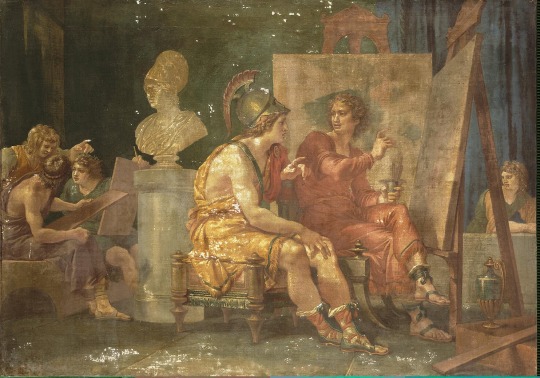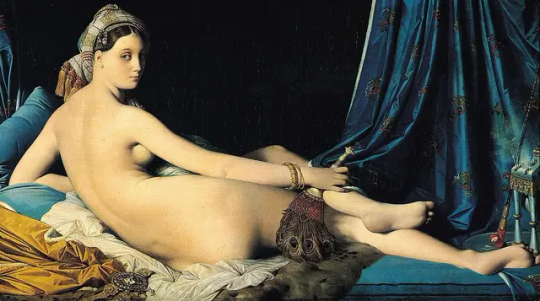#neoclassical painter
Explore tagged Tumblr posts
Text


Jacques-Louis David (French, 1748-1825) • Self-portrait • 1794 • Musée du Louvre
Jacques-Louis David painted this self-portrait while imprisoned at the Hôtel des Fermes for having supported the Robespierreans. It was his third and last self-portrait.
" To give a body and a perfect form to one's thought, this - and only this - is to be an artist. " – Jacques-Louis David
#art#art history#oil painting#painting#self portrait#jacque-louis david#french artist#neoclassical painter#louvre museum#artist as subject#the canvas mirror art blog
37 notes
·
View notes
Text

Johann Zoffany (German, 1733-1810) • Colonel Blair with his Family and an Indian Ayah • 1786 • Tate Britain
#art#fine art#painting#art history#oil painting#johann zoffany#german artist#genre painting#animals in artworks#late 18th century european art#neoclassical painter#the painted room art blog#paintings of interiors#paintings of domestic interiors
42 notes
·
View notes
Text

THE DEATH OF GENERAL WOLFE | 1770 | by BENJAMIN WEST
In the painting the central figure is GENERAL WOLFE, lying on his back with his arms outstretched and his eyes turned towards the heavens. He is surrounded by a group of soldiers, officers, and Native Americans, all of whom are depicted in various states of grief and shock.
The figures in the painting are dressed in historically accurate military uniforms and NATIVE AMERICAN clothing. At the center is GENERAL WOLFE, dressed in his red coat and pointing towards the sky. This gesture symbolizes his final victory and his transcendence into a hero. His pose is reminiscent of the crucifixion of JESUS, further emphasizing his sacrifice for his country.
To the left of Wolfe is a NATIVE AMERICAN WARRIOR, mourning the death of his ally. He is depicted in a powerful pose, with his arms raised and his face twisted in anguish. This figure represents the alliance between the BRITISH and NATIVE AMERICANS during the war.
On the right side of the painting, two officers are depicted in shock and grief. One of them is holding a handkerchief to his face, while the other is looking towards the sky with a mix of sorrow and admiration. These figures represent the impact of WOLFE'S death on those who knew and fought alongside him.
The Death of General Wolfe was a significant painting in its time, as it was one of the first historical paintings to be exhibited in a public space. It was displayed at the ROYAL ACADEMY OF ARTS in LONDON, where it received critical acclaim and helped establish West as a leading artist of his time.
#the death of general wolfe#benjamin west#neo expressionist#neoclassical art#neoclassicism#neoclassical#Neoclassical painting#Neoclassical painter
2 notes
·
View notes
Text

Portrait of Francois-Andre Vincent
Artist: Adélaïde Labille-Guiard (French, 1749–1803)
Genre: Portrait
Date: 1795
Medium: Oil on Canvas
Collection: Louvre Museum, Paris, France
François-André Vincent
François-André Vincent (30 December 1746 – 4 August 1816) was a French neoclassical painter.
Vincent was born in Paris in 1746, the son of the miniaturist François-Elie Vincent. He studied under Joseph-Marie Vien and was a pupil of École Royale des Éleves Protégés. From 1771 to 1775 he studied at the French Academy in Rome. He travelled to Rome after winning the Prix de Rome with Germanicus Calms Sedition in his Camp in 1768, and was when he was installed at the Palais Mancini, where he painted numerous portraits, inspired by Jean-Honoré Fragonard's style, who also was visiting Rome and Naples in the same time.
In 1790, Vincent was appointed master of drawings to Louis XVI of France, and in 1792 he became a professor at the Académie royale de peinture et de sculpture in Paris. In 1800, he married the painter Adélaïde Labille-Guiard who was well known for her mastery in portrait painting, a member of the Royal Academy and painter for the Royal Family.
#portrait#francois andre vincent#french painter#adelaide labille guiard#european#french#artist#neoclassical painter#18th century painting
1 note
·
View note
Text



Details from the painting Medea meditating on killing her children (1852), by Bezzuoli.
#art#artworks#artwork#paintings#painting#art history#romantic movement#romanticism#the romantics#romantic art#neoclassicism#neoclassical art#italian artists#italian painters#bezzuoli#ancient greece#ancient rome#greco roman mythology#greek mythology#roman mythology#mythology#jason and the golden fleece#jason and the argonauts#jason and medea#medea#femme fatale#feminism#feminist icon#witches#witchcraft
2K notes
·
View notes
Text

Maternal Affection
Artist: Louis Jean François Lagrenée (French, 1725-1805)
Date: 1755
Medium: Oil on Copper
Collection: The National Gallery, London
Description
In this exquisite small painting on copper, three women are looking after two infants in a grand neoclassical setting. One woman breastfeeds an infant, while another holds up a second baby for a kiss. A woman to the left is busy arranging bedding in a wooden cradle. The open loggia and warm light suggest that the scene takes place in a southern climate. To an eighteenth-century audience, the women’s clothing would have been understood as antique Roman dress.
The painting shares similarities with a series of eight paintings by Lagrenée at Stourhead in Wiltshire. It may be Lagrenée’s painting formerly at Stourhead, described as ‘Maternal Affection – a beautiful group’. The subject was of special interest for a contemporary audience as motherhood, and particularly the practice of breastfeeding one’s own children rather than sending them out to a wet nurse, was much discussed in both France and England at the time.
#painting#genre art#oil on copper#louis jea francos lagrenee#french painter#women#babies#breastfeeding#neoclassical#roman costume#textiles#pillow#crib#18th century painting#trees#sky#classic pillars#drapes
84 notes
·
View notes
Photo

Detail from An allegory of sculpture and architecture by Thomas Germain Joseph Duvivier
#Thomas Germain Joseph Duvivier#neoclassicism#neoclassical art#art#art detail#art details#sculpture#women in art#painting#oil painting#french painter#french art
2K notes
·
View notes
Text

Dante in Hell
Artist: Hippolyte Flandrin (French, 1809-1864)
Date: 1835
Medium: Oil on canvas
Museum of Fine Arts, Lyon, France
Description
Dante in Hell or Dante, led by Virgil, Consoles the Souls of the Envious is an 1835 oil painting on canvas by the French painter Hippolyte Flandrin. Contrary to its primary title, it shows a scene from the Circle of the Envious, the second circle of Purgatory in Canto III of Purgatorio. The scene depicts Dante on the mountain of Purgatorio trying to comfort the blind men. It is now in the Museum of Fine Arts of Lyon.
Inferno (Dante)
Inferno (Italian for 'Hell') is the first part of Italian writer Dante Alighieri's 14th-century narrative poem The Divine Comedy, followed by Purgatorio and Paradiso. The Inferno describes the journey of a fictionalised version of Dante himself through Hell, guided by the ancient Roman poet Virgil. In the poem, Hell is depicted as nine concentric circles of torment located within the Earth; it is the "realm […] of those who have rejected spiritual values by yielding to bestial appetites or violence, or by perverting their human intellect to fraud or malice against their fellow men". As an allegory, the Divine Comedy represents the journey of the soul toward God, with the Inferno describing the recognition and rejection of sin.
#painting#oil on canvas#genre art#dante in hell#artwork#fine art#oil painting#dante#virgil#souls of the envious#dante's inferno#the divine comedy#italian literature#neoclassical style#french art#hippolyte flandrin#french painter#european art#19th century painting
45 notes
·
View notes
Text

Robert Huskisson, Lord Northwick's Picture Gallery at Thirlestaine House, c. 1846-47, oil on canvas.
#robert huskisson#thirlestaine#english art#english artist#english painter#english design#oil on canvas#dog#dogs in art#19th century#19th century art#interior#paintings#interior design#neoclassical#picture gallery#period design#nineteenth century interior#art#artwork#painting#design#drawing#decor#period decor#zimmerbild#red#gloucestershire#cheltenham
22 notes
·
View notes
Text

Alexander the Great in the Workshop of Apelles by Giuseppe Cades
#alexander the great#apelles#art#giuseppe cades#ancient greece#painter#painting#ancient greek#history#alexander#macedonia#macedonian#macedon#greece#greek#sculptures#sculpture#europe#european#classical antiquity#neoclassical#neoclassicism#artist#mediterranean
139 notes
·
View notes
Text

Achilles Receiving the Envoys of Agamemnon
Artist: Jean-Auguste-Dominique Ingres (French, 1780–1867)
Date: 1801
Medium: Oil on Canvas
Collection: Beaux-Arts de Paris, Paris, France
Description
This painting shows an episode from Homer's Iliad, in which Achilles refuses to listen to the envoys sent by Agamemnon to convince him back into the Trojan War. The topic assigned for the artists competing for the Prix de Rome in 1801 was the warriors' procession toward battle; Ingres' interpretation of the subject characteristically emphasized a moment of psychological drama instead of physical action. The work was intended as a demonstration of Ingres' mastery of the human figure in classical history painting – Odysseus is shown in a red cloak derived from a sculpture by Pseudo-Phidias.
#painting#oil on canvas#mythological art#jean auguste dominique ingres#french painter#homer's iliad#achilles#envoys#trojan war#neoclassical#landscape#male figures#nude figures#early 19th century#european art#greek mythology
30 notes
·
View notes
Text










NEOCLASSICAL & ROMANTIC ART ⚖️ love, ur local art mom 🩵
disclaimers and more information under the cut ✂️
hi I’m annemarie and I’m an art historian! not adjuncting for the first time in five years was rly hard for me so I threw some slides together so I could still (sort of) teach the same material as my language of art class but a) I threw these slides together for instagram so space was/is limited and b) language of art is a ten week run through art history so I’m presenting only the most accessible information here – there’s so much more to this art period and to these artists! – please don’t expect it to be comprehensive and please do ask if you have any questions!
oh p.s. my first ever class of art history students came up with the name ‘art mom’ for me at the end of the quarter and yes it does make me cry if I think about it too long thanks so much for asking
#annemarie teaches art history#art history#neoclassical art#neoclassical#neoclassicism#romantic art#romantic#romanticism#classical antiquity#neoclassical painters#neoclassical painting#jacques-louis david#oath of the horatii#romantic thinkers#romantic ideals#liberty leading the people#eugène delacroix#romantic painters#mary edmonia lewis#edmonia lewis#hiawatha's marriage#francisco josé de goya#goya#the third of may#art mom#annemarieyeretzian
17 notes
·
View notes
Text

#jean auguste dominique ingres#art#paintings#fine art#19th century#19th century art#neoclassical#neoclassical art#neoclassicism#painting#french artist#french art#mythology#greek mythology#greek heroes#perseus#andromeda#classic art#handmade#oil on canvas#reproduction#classical art#art blog#oil painting#artwork#Jean Auguste Dominique Ingres#ingres#henri rousseau#edouard manet#french painter
26 notes
·
View notes
Text

Portrait of Constance Pipelet
Artist: Jean-Baptiste-François Desoria (French, 1758–1832)
Date: 1797
Medium: Oil on canvas
Collection: Art Institute of Chicago, Chicago, IL, United States
Description
Painted in the aftermath of the French Revolution, Désoria’s Portrait of Constance Pipelet typifies the Neoclassical style of portraiture practiced by Jacques-Louis David and his circle. The figure, placed parallel to the picture plane and silhouetted against the bright blue of the sky, evokes antique relief sculpture. Her white cotton dress was the fashionable attire of middle- and upper-class women in the 1790s, its antique associations reflecting Neoclassical ideals and its simplicity echoing the egalitarian spirit of the new French Republic. Constance Pipelet, later Constance de Salm-Dyck, was a noted poet, librettist, and feminist with a salon that attracted the literary and artistic notables of Paris.
#neoclassical art#portrait#french culture#painting#constance pipelet#oil on canvas#fine art#oil painting#artwork#french art#woman#three quarter length#seated#white dress#chair#book#curly hair#mountains#jean baptiste francois desoria#french painter#european art#18th century painting#art institute of chicago
26 notes
·
View notes
Text

The Mirror
Artist: Lawrence Alma-Tadema (Dutch, 1836-1912)
Date: 1868
Medium: Oil on Canvas
#woman#man#mirror#neoclassical#lawrence alma tadema#Dutch painter#roman#19th century painting#plant#floral crown#european#couple
46 notes
·
View notes
Photo


An allegory of sculpture and architecture by Thomas Germain Joseph Duvivier
#Thomas Germain Joseph Duvivier#neoclassicism#still life#art#art details#18th century art#neoclassical art#art history#painting#oil painting#oil on canvas#sculpture#french art#french painter#french old masters#dark academia
240 notes
·
View notes